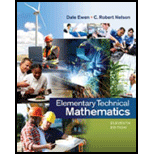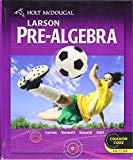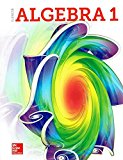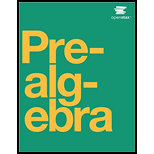
Student Solutions Manual For Ewen/nelson's Elementary Technical Mathematics, 11th
11th Edition
ISBN: 9781285199276
Author: Dale Ewen
Publisher: Cengage Learning
expand_more
expand_more
format_list_bulleted
Question
Chapter 16, Problem 14CR
To determine
To calculate: The volume of the sphere whose radius is .
Expert Solution & Answer
Want to see the full answer?
Check out a sample textbook solution
Students have asked these similar questions
A small college has 800students, 10% of which are left-handed. Suppose they take an
SRS
of 8students. Let [L=] the number of left-handed students in the sample.
Which of the following would find [P(L=2)]?
This table displays the current in equal intervals.
Time t/ms 05
10 15 20 25 30
Current i/A 0 4.8 9.1 12.7 8.8 3.5 0
The formula for the charge as follows:
30x10-3
q
0
i dt
Use formula to solve the current at 30ms using both the trapezoidal rule and Simpson's
rule showing all steps and working
Table displays the current in equal intervals.
Charge formula:
Time t/m 05 10 15
20 25 30
Current i/A 0 4.8 9.1 12.7 8.8 3.5 0
9 =
70
30x10-3
i dt
Using mid-ordinate rule solve for the current at 30ms.
Chapter 16 Solutions
Student Solutions Manual For Ewen/nelson's Elementary Technical Mathematics, 11th
Ch. 16.1 - Change each binary number to decimal form: 11Ch. 16.1 - Prob. 2ECh. 16.1 - Prob. 3ECh. 16.1 - Prob. 4ECh. 16.1 - Prob. 5ECh. 16.1 - Prob. 6ECh. 16.1 - Prob. 7ECh. 16.1 - Prob. 8ECh. 16.1 - Prob. 9ECh. 16.1 - Prob. 10E
Ch. 16.1 - Prob. 11ECh. 16.1 - Prob. 12ECh. 16.1 - Prob. 13ECh. 16.1 - Prob. 14ECh. 16.1 - Prob. 15ECh. 16.1 - Prob. 16ECh. 16.1 - Change each binary number to decimal form:...Ch. 16.1 - Prob. 18ECh. 16.1 - Change each binary number to decimal form: 111111Ch. 16.1 - Prob. 20ECh. 16.2 - Prob. 1ECh. 16.2 - Prob. 2ECh. 16.2 - Prob. 3ECh. 16.2 - Prob. 4ECh. 16.2 - Prob. 5ECh. 16.2 - Prob. 6ECh. 16.2 - Prob. 7ECh. 16.2 - Prob. 8ECh. 16.2 - Prob. 9ECh. 16.2 - Prob. 10ECh. 16.2 - Prob. 11ECh. 16.2 - Prob. 12ECh. 16.2 - Prob. 13ECh. 16.2 - Prob. 14ECh. 16.2 - Prob. 15ECh. 16.2 - Add the following binary numbers and check your...Ch. 16.2 - Prob. 17ECh. 16.2 - Prob. 18ECh. 16.2 - Prob. 19ECh. 16.2 - Prob. 20ECh. 16.2 - Prob. 21ECh. 16.2 - Prob. 22ECh. 16.2 - Prob. 23ECh. 16.2 - Add the following binary numbers and check your...Ch. 16.2 - Prob. 25ECh. 16.2 - Prob. 26ECh. 16.2 - Add the following binary numbers and check your...Ch. 16.2 - Prob. 28ECh. 16.2 - Prob. 29ECh. 16.2 - Prob. 30ECh. 16.3 - Prob. 1ECh. 16.3 - Prob. 2ECh. 16.3 - Subtract the following binary numbers and check in...Ch. 16.3 - Prob. 4ECh. 16.3 - Subtract the following binary numbers and check in...Ch. 16.3 - Subtract the following binary numbers and check in...Ch. 16.3 - Prob. 7ECh. 16.3 - Prob. 8ECh. 16.3 - Prob. 9ECh. 16.3 - Subtract the following binary numbers and check in...Ch. 16.3 - Subtract the following binary numbers and check in...Ch. 16.3 - Prob. 12ECh. 16.3 - Prob. 13ECh. 16.3 - Prob. 14ECh. 16.3 - Subtract the following binary numbers and check in...Ch. 16.3 - Prob. 16ECh. 16.3 - Prob. 17ECh. 16.3 - Subtract the following binary numbers and check in...Ch. 16.3 - Prob. 19ECh. 16.3 - Prob. 20ECh. 16.3 - Prob. 21ECh. 16.3 - Prob. 22ECh. 16.3 - Prob. 23ECh. 16.3 - Prob. 24ECh. 16.3 - Prob. 25ECh. 16.3 - Prob. 26ECh. 16.3 - Prob. 27ECh. 16.3 - Prob. 28ECh. 16.3 - Prob. 29ECh. 16.3 - Use the 1s complement method to subtract the...Ch. 16.3 - Prob. 31ECh. 16.3 - Prob. 32ECh. 16.3 - Prob. 33ECh. 16.3 - Prob. 34ECh. 16.3 - Prob. 35ECh. 16.3 - Prob. 36ECh. 16.4 - Prob. 1ECh. 16.4 - Prob. 2ECh. 16.4 - Multiply the following binary numbers: 11010_Ch. 16.4 - Prob. 4ECh. 16.4 - Prob. 5ECh. 16.4 - Prob. 6ECh. 16.4 - Prob. 7ECh. 16.4 - Prob. 8ECh. 16.4 - Prob. 9ECh. 16.4 - Prob. 10ECh. 16.4 - Prob. 11ECh. 16.4 - Prob. 12ECh. 16.4 - Prob. 13ECh. 16.4 - Multiply the following binary numbers: 101101101_Ch. 16.4 - Prob. 15ECh. 16.4 - Prob. 16ECh. 16.4 - Prob. 17ECh. 16.4 - Prob. 18ECh. 16.4 - Prob. 19ECh. 16.4 - Prob. 20ECh. 16.5 - Prob. 1ECh. 16.5 - Prob. 2ECh. 16.5 - Prob. 3ECh. 16.5 - Prob. 4ECh. 16.5 - Prob. 5ECh. 16.5 - Prob. 6ECh. 16.5 - Prob. 7ECh. 16.5 - Prob. 8ECh. 16.5 - Prob. 9ECh. 16.5 - Prob. 10ECh. 16.5 - Prob. 11ECh. 16.5 - Prob. 12ECh. 16.5 - Prob. 13ECh. 16.5 - Prob. 14ECh. 16.5 - Prob. 15ECh. 16.5 - Prob. 16ECh. 16.5 - Prob. 17ECh. 16.5 - Prob. 18ECh. 16.5 - Prob. 19ECh. 16.5 - Prob. 20ECh. 16.6 - Prob. 1ECh. 16.6 - Prob. 2ECh. 16.6 - Prob. 3ECh. 16.6 - Prob. 4ECh. 16.6 - Prob. 5ECh. 16.6 - Prob. 6ECh. 16.6 - Prob. 7ECh. 16.6 - Prob. 8ECh. 16.6 - Prob. 9ECh. 16.6 - Prob. 10ECh. 16.6 - Prob. 11ECh. 16.6 - Prob. 12ECh. 16.6 - Prob. 13ECh. 16.6 - Prob. 14ECh. 16.6 - Prob. 15ECh. 16.6 - Prob. 16ECh. 16.6 - Prob. 17ECh. 16.6 - Prob. 18ECh. 16.6 - Prob. 19ECh. 16.6 - Change each binary number to decimal form:...Ch. 16.7 - Prob. 1ECh. 16.7 - Prob. 2ECh. 16.7 - Prob. 3ECh. 16.7 - Prob. 4ECh. 16.7 - Prob. 5ECh. 16.7 - Prob. 6ECh. 16.7 - Prob. 7ECh. 16.7 - Prob. 8ECh. 16.7 - Prob. 9ECh. 16.7 - Prob. 10ECh. 16.7 - Prob. 11ECh. 16.7 - Prob. 12ECh. 16.7 - Prob. 13ECh. 16.7 - Change each hexadecimal number to decimal form:...Ch. 16.7 - Prob. 15ECh. 16.7 - Prob. 16ECh. 16.7 - Prob. 17ECh. 16.7 - Prob. 18ECh. 16.7 - Prob. 19ECh. 16.7 - Prob. 20ECh. 16.7 - Prob. 21ECh. 16.7 - Prob. 22ECh. 16.7 - Prob. 23ECh. 16.7 - Prob. 24ECh. 16.7 - Prob. 25ECh. 16.7 - Prob. 26ECh. 16.7 - Prob. 27ECh. 16.7 - Prob. 28ECh. 16.7 - Prob. 29ECh. 16.7 - Prob. 30ECh. 16.8 - Prob. 1ECh. 16.8 - Prob. 2ECh. 16.8 - Prob. 3ECh. 16.8 - Prob. 4ECh. 16.8 - Prob. 5ECh. 16.8 - Prob. 6ECh. 16.8 - Prob. 7ECh. 16.8 - Prob. 8ECh. 16.8 - Prob. 9ECh. 16.8 - Prob. 10ECh. 16.8 - Prob. 11ECh. 16.8 - Prob. 12ECh. 16.8 - Prob. 13ECh. 16.8 - Prob. 14ECh. 16.8 - Prob. 15ECh. 16.8 - Prob. 16ECh. 16.8 - Prob. 17ECh. 16.8 - Prob. 18ECh. 16.8 - Prob. 19ECh. 16.8 - Prob. 20ECh. 16.8 - Prob. 21ECh. 16.8 - Prob. 22ECh. 16.8 - Prob. 23ECh. 16.8 - Prob. 24ECh. 16.8 - Prob. 25ECh. 16.8 - Prob. 26ECh. 16.8 - Add the following hexadecimal numbers. Check using...Ch. 16.8 - Prob. 28ECh. 16.8 - Prob. 29ECh. 16.8 - Prob. 30ECh. 16.8 - Prob. 31ECh. 16.8 - Prob. 32ECh. 16.8 - Prob. 33ECh. 16.8 - Prob. 34ECh. 16.8 - Prob. 35ECh. 16.8 - Prob. 36ECh. 16.8 - Prob. 37ECh. 16.8 - Prob. 38ECh. 16.8 - Prob. 39ECh. 16.8 - Prob. 40ECh. 16.8 - Prob. 41ECh. 16.8 - Prob. 42ECh. 16.8 - Prob. 43ECh. 16.8 - Prob. 44ECh. 16.8 - Prob. 45ECh. 16.8 - Prob. 46ECh. 16.8 - Prob. 47ECh. 16.8 - Prob. 48ECh. 16.8 - Prob. 49ECh. 16.8 - Prob. 50ECh. 16.8 - Prob. 51ECh. 16.8 - Prob. 52ECh. 16.8 - Prob. 53ECh. 16.8 - Prob. 54ECh. 16.8 - Prob. 55ECh. 16.8 - Prob. 56ECh. 16.8 - Prob. 57ECh. 16.8 - Prob. 58ECh. 16.8 - Prob. 59ECh. 16.8 - Prob. 60ECh. 16.9 - Prob. 1ECh. 16.9 - Prob. 2ECh. 16.9 - Prob. 3ECh. 16.9 - Prob. 4ECh. 16.9 - Prob. 5ECh. 16.9 - Prob. 6ECh. 16.9 - Prob. 7ECh. 16.9 - Prob. 8ECh. 16.9 - Prob. 9ECh. 16.9 - Prob. 10ECh. 16.9 - Prob. 11ECh. 16.9 - Prob. 12ECh. 16.9 - Prob. 13ECh. 16.9 - Prob. 14ECh. 16.9 - Prob. 15ECh. 16.9 - Prob. 16ECh. 16.9 - Prob. 17ECh. 16.9 - Prob. 18ECh. 16.9 - Prob. 19ECh. 16.9 - Prob. 20ECh. 16.9 - Prob. 21ECh. 16.9 - Prob. 22ECh. 16.9 - Prob. 23ECh. 16.9 - Change each binary number to hexadecimal form:...Ch. 16.9 - Prob. 25ECh. 16.9 - Prob. 26ECh. 16.9 - Prob. 27ECh. 16.9 - Prob. 28ECh. 16.9 - Prob. 29ECh. 16.9 - Prob. 30ECh. 16.9 - Prob. 31ECh. 16.9 - Prob. 32ECh. 16.9 - Prob. 33ECh. 16.9 - Prob. 34ECh. 16.9 - Prob. 35ECh. 16.9 - Prob. 36ECh. 16.9 - Prob. 37ECh. 16.9 - Prob. 38ECh. 16.9 - Prob. 39ECh. 16.9 - Prob. 40ECh. 16.9 - Prob. 41ECh. 16.9 - Prob. 42ECh. 16.9 - Prob. 43ECh. 16.9 - Prob. 44ECh. 16 - Prob. 1RCh. 16 - Prob. 2RCh. 16 - Prob. 3RCh. 16 - Prob. 4RCh. 16 - Prob. 5RCh. 16 - Prob. 6RCh. 16 - Add the following binary numbers: 1001110101_Ch. 16 - Prob. 8RCh. 16 - Prob. 9RCh. 16 - Prob. 10RCh. 16 - Prob. 11RCh. 16 - Prob. 12RCh. 16 - Prob. 13RCh. 16 - Prob. 14RCh. 16 - Prob. 15RCh. 16 - Prob. 16RCh. 16 - Prob. 17RCh. 16 - Prob. 18RCh. 16 - Prob. 19RCh. 16 - Prob. 20RCh. 16 - Prob. 21RCh. 16 - Prob. 22RCh. 16 - Prob. 23RCh. 16 - Prob. 24RCh. 16 - Prob. 25RCh. 16 - Prob. 26RCh. 16 - Prob. 27RCh. 16 - Prob. 28RCh. 16 - Prob. 29RCh. 16 - Prob. 30RCh. 16 - Prob. 1TCh. 16 - Prob. 2TCh. 16 - Prob. 3TCh. 16 - Prob. 4TCh. 16 - Prob. 5TCh. 16 - Prob. 6TCh. 16 - Prob. 7TCh. 16 - Prob. 8TCh. 16 - Prob. 9TCh. 16 - Prob. 10TCh. 16 - Prob. 11TCh. 16 - Prob. 12TCh. 16 - Prob. 13TCh. 16 - Prob. 14TCh. 16 - Prob. 15TCh. 16 - Prob. 16TCh. 16 - Prob. 17TCh. 16 - Prob. 18TCh. 16 - Prob. 19TCh. 16 - Prob. 20TCh. 16 - Prob. 1CRCh. 16 - Prob. 2CRCh. 16 - Prob. 3CRCh. 16 - Prob. 4CRCh. 16 - Prob. 5CRCh. 16 - Prob. 6CRCh. 16 - Prob. 7CRCh. 16 - Prob. 8CRCh. 16 - Prob. 9CRCh. 16 - Prob. 10CRCh. 16 - Prob. 11CRCh. 16 - Prob. 12CRCh. 16 - Prob. 13CRCh. 16 - Prob. 14CRCh. 16 - Prob. 15CRCh. 16 - Prob. 16CRCh. 16 - Prob. 17CRCh. 16 - Prob. 18CRCh. 16 - Prob. 19CRCh. 16 - Prob. 20CRCh. 16 - Prob. 21CRCh. 16 - Prob. 22CRCh. 16 - Prob. 23CRCh. 16 - Prob. 24CRCh. 16 - Do as indicated for the following binary numbers:...Ch. 16 - Prob. 26CRCh. 16 - Prob. 27CRCh. 16 - Prob. 28CRCh. 16 - Prob. 29CRCh. 16 - Prob. 30CR
Knowledge Booster
Learn more about
Need a deep-dive on the concept behind this application? Look no further. Learn more about this topic, subject and related others by exploring similar questions and additional content below.Similar questions
- If x 2, prove that, for some constant B, σo(n) n5 = B log x +0(x-4). 4x4 n≤x You may assume that -5 -4 1 Σ₁ = K −x + O(x¯5) and Σ q¯¹ = log x + C + O(x−¹). AM - q≤xarrow_forward(i) Use Abel's identity to prove that, for any s > 1, Σ narrow_forwardLet p be an odd prime. (a) Let 1≤ k ≤ p −1 and let k¹ denote the multiplicative inverse of k modulo p. Show that k(k+1) is a quadratic residue modulo p if and only if 1+k¹ is a quadratic residue modulo p.arrow_forward
- Let p be an odd prime. (a) Let 1≤ k ≤ p −1 and let k-1 denote the multiplicative inverse of k(k+1) is a quadratic residue modulo p if k modulo p. and only if 1+k¹ is a quadratic residue modulo p. (b) Using part (a), find the integer N such that p-2 ΣΚΑ Σ(k(k+1)|p) = N. k=1arrow_forwardDetermine all pairs of primes (p,q) for which p−1 + q³−1 = 1 (mod pq). Hint: First consider the case p = q.arrow_forwardDetermine all integers n for which ϕ(n) = 32.arrow_forward
- Construct a whole table showing the values of all the real-valued Dirichlet characters modulo 28.(You must show full working for at least one full row of the tablethat is not the principal character.)arrow_forwardUsing Wilson's theorem, prove that, for every prime p and positive integer a, aP(p-1)!a and (p-1)! a² + a are both divisible by p.arrow_forwardLet f and g be continuous, positive functions defined on the interval [0, ∞). Prove or disprove the following statements, giving a counterexample in the case that a statement is false: (i) If f(x) = O(g(x)), then h(x) = g(x)/f(x) is bounded. (ii) If g(x) = O(f(x)), then h(x) = g(x)/f(x) is bounded.arrow_forward
- y = 7.4e-0.5v sin (1.2v) the value of v where y = 0 for v between 0 and 2π. Using bisection method and newton- Raphson method.arrow_forward[2 01 3. (12 pts) Let A = 1 1 and b = 1 L2 1] 213 [2] (1) (2) Use the Gram-Schmidt process to find an orthonormal basis for the column space of A. Factor A into a product QR, where Q has an orthonormal set of column vectors and R is upper triangular. (3) Solve the least squares problem Ax = b.arrow_forwardA person is interested in constructing a portfolio. Two stocks are being considered. Let x percent return for an investment in stock 1, and y = percent return for an investment in stock 2. The expected return and variance for stock 1 are E(x) = 8.45% and Var(x) = 25. The expected return and variance for stock 2 are E(y) = 3.20% and Var(y) = 1. The covariance between the returns is σ = −3. a. What is the standard deviation for an investment in stock 1 and for an investment in stock 2? Using the standard deviation as a measure of risk, which of these stocks is the riskier investment? b. What is the expected return and standard deviation, in dollars, for a person who invests $500 in stock 1? C. What is the expected percent return and standard deviation for a person who constructs a portfolio by investing 50% in each stock? d. What is the expected percent return and standard deviation for a person who constructs a portfolio by investing 70% in stock 1 and 30% in stock 2? e. Compute the…arrow_forward
arrow_back_ios
SEE MORE QUESTIONS
arrow_forward_ios
Recommended textbooks for you
 Holt Mcdougal Larson Pre-algebra: Student Edition...AlgebraISBN:9780547587776Author:HOLT MCDOUGALPublisher:HOLT MCDOUGAL
Holt Mcdougal Larson Pre-algebra: Student Edition...AlgebraISBN:9780547587776Author:HOLT MCDOUGALPublisher:HOLT MCDOUGAL Glencoe Algebra 1, Student Edition, 9780079039897...AlgebraISBN:9780079039897Author:CarterPublisher:McGraw Hill
Glencoe Algebra 1, Student Edition, 9780079039897...AlgebraISBN:9780079039897Author:CarterPublisher:McGraw Hill Elementary Geometry For College Students, 7eGeometryISBN:9781337614085Author:Alexander, Daniel C.; Koeberlein, Geralyn M.Publisher:Cengage,
Elementary Geometry For College Students, 7eGeometryISBN:9781337614085Author:Alexander, Daniel C.; Koeberlein, Geralyn M.Publisher:Cengage,
 Mathematics For Machine TechnologyAdvanced MathISBN:9781337798310Author:Peterson, John.Publisher:Cengage Learning,
Mathematics For Machine TechnologyAdvanced MathISBN:9781337798310Author:Peterson, John.Publisher:Cengage Learning, Elementary Geometry for College StudentsGeometryISBN:9781285195698Author:Daniel C. Alexander, Geralyn M. KoeberleinPublisher:Cengage Learning
Elementary Geometry for College StudentsGeometryISBN:9781285195698Author:Daniel C. Alexander, Geralyn M. KoeberleinPublisher:Cengage Learning

Holt Mcdougal Larson Pre-algebra: Student Edition...
Algebra
ISBN:9780547587776
Author:HOLT MCDOUGAL
Publisher:HOLT MCDOUGAL

Glencoe Algebra 1, Student Edition, 9780079039897...
Algebra
ISBN:9780079039897
Author:Carter
Publisher:McGraw Hill

Elementary Geometry For College Students, 7e
Geometry
ISBN:9781337614085
Author:Alexander, Daniel C.; Koeberlein, Geralyn M.
Publisher:Cengage,


Mathematics For Machine Technology
Advanced Math
ISBN:9781337798310
Author:Peterson, John.
Publisher:Cengage Learning,

Elementary Geometry for College Students
Geometry
ISBN:9781285195698
Author:Daniel C. Alexander, Geralyn M. Koeberlein
Publisher:Cengage Learning
Surface Area Of A Sphere | Geometry | Math | Letstute; Author: Let'stute;https://www.youtube.com/watch?v=T_DBkFnr4NM;License: Standard YouTube License, CC-BY







